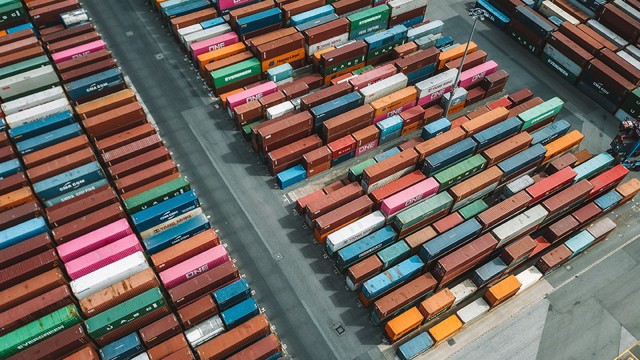October 10, 2025
Germany stuck in the slow lane
From bad to worse – and the streak continues.


To the point!

How many more wake-up calls will it take for Europeans to understand that Europe’s only chance lies in working together?
The flood of grim news from the German economy, particularly the industrial sector, shows no signs of letting up. It feels like every week, well-known companies – especially in the automo-tive industry – announce that they need to “adjust” their work-force to reflect sluggish demand. In plain terms: tens of thousands of jobs in Germany are being cut. Insolvency figures have climbed back above pre-Covid levels, and the closely watched ifo Business Climate Index has dipped again in September after a brief period of mild improvements. Confidence is low across the board. The last time the ifo Expectations Index matched the average of the past two decades was at the beginning of 2022.
The malaise facing the German economy is more than just a cyclical downturn. It’s the result of a tangled web of problems and structural missteps. LBBW Research outlined these numerous structural obstacles in its stagnation study back in the fall of 2024. One year on, we are still in the same spot.
Waiting and hoping are not strategies
Adding insult to injury, external shocks are now piling on top of structural challenges. The overpowering protectionism of the Trump administration (well, let’s strike the word “administration” – Washington has essentially become a one-man show) is hitting Germany particularly hard. Few countries have been as reliant on export-driven growth over the past decades as Germany (see Fig. 1 in PDF). Alas, the golden age of globalization is long gone. And now Trump is slamming on the accelerator in reverse.
One of the unwelcome side effects of this is becoming increasingly clear: the U.S. is walling off its market from Chinese exports with particularly high tariffs. But China needs export success, as its domestic market struggles to regain momentum amid a shrinking workforce, a stubborn real estate crisis, and high debt levels. Struggling with overcapacity and U.S. protectionism, Chinese manufacturers are inundating other parts of the world with their often heavily subsidized products, including Europe. Germany finds itself squeezed from both sides: the rising tide of trade barriers make exporting more difficult, while heightened competition is putting pressure on the domestic market.
Time to seize the initiative
There are various ways to respond to these challenges. One approach might be summarized as “an eye for an eye, a tooth for a tooth.” In fact, the Brussels grapevine suggests that the EU is preparing a package of tariffs on Chinese goods along with “Buy European” rules. This week, we got a preview of this approach, with the announcement of a 50% tariff on steel. Austria’s Minister of Economic Affairs, Wolfgang Hattmannsdorfer, has even called for a “protection shield” for European industry: “We need to act more protectionist and patriotically European.” Sounds a lot like "Make Europe Great Again." Some seem to succumb to the temptation to take a page out of Trump’s isolationist playbook.
I do believe it’s absolutely justifiable to impose countervailing du-ties on dumped goods from Asia. But protectionism, in and of itself, does not deliver prosperity. Incidentally, MAGA loyalists will come to realize this as well. After all, America has never been as “great” as it is now, following decades of free trade.
Yet, the time Europe gains with China tariffs must be used wisely. The EU must double down on efforts to close the technological gap. If Europe instead clings nostalgically to an irretrievably bygone era of industrial dominance, the decline will only accelerate (see Fig. 2 in PDF). Why Germany still identifies itself as an “industrialized nation” when 80% of its value creation now comes from outside the manufacturing sector? And when some German politicians these days talk about 'technological openness,' do they perhaps mean they want everything to stay as it was back when the country reigned supreme? Ignoring technological progress and structural change won’t turn the tide. In my view, there’s too much focus on the past and not enough on the future.
Just over a year ago, the Draghi report provided a blueprint for a competitive Europe. Yet, only about a tenth of its recommendations have been implemented so far. The much-needed €800 billion annual investment offensive is nowhere to be seen. Progress on completing the EU single market remains elusive. According to IMF estimates, the trade barriers within the EU are equivalent to an average tariff of 40% on goods – and even higher for services. Completing the internal European market is now more urgent than ever. It will require that each country will need to put its narrowly defined national interest on the back seat. How many more wake-up calls will it take for Europeans to understand that Europe’s only chance lies in working together?
Dr. Moritz Kraemer, Chief Economist / Head of Research at LBBW
Download To the point!
-
1.2 MB | October 02, 2025
This publication is addressed exclusively at recipients in the EU, Switzerland, Liechtenstein and the United Kingdom.
This report is not being distributed by LBBW to any person in the United States and LBBW does not intend to solicit any person in the United States.
LBBW is under the supervision of the European Central Bank (ECB), Sonnemannstraße 22, 60314 Frankfurt/Main (Germany) and the German Federal Financial Supervisory Authority (BaFin), Graurhein-dorfer Str. 108, 53117 Bonn (Germany) / Marie-Curie-Str. 24-28, 60439 Frankfurt/Main (Germany).
This publication is based on generally available sources which we are not able to verify but which we believe to be reliable. Nevertheless, we assume no liability for the accuracy and completeness of this publication. It conveys our non-binding opinion of the market and the products at the time of the editorial deadline, irrespective of any own holdings in these products. This publication does not replace individual advice. It serves only for informational purposes and should not be seen as an offer or request for a purchase or sale. For additional, more timely in-formation on concrete investment options and for indi-vidual investment advice, please contact your investment advisor.
We retain the right to change the opinions expressed herein at any time and without prior notice. More-over, we retain the right not to update this information or to stop such updates entirely without prior notice.
Past performance, simulations and forecasts shown or described in this publication do not constitute a reliable indicator of future performance.
The acceptance of provided research services by a securities services company can qualify as a benefit in supervisory law terms. In these cases LBBW assumes that the benefit is intended to improve the quality of the relevant service for the customer of the benefit recipient.
Additional Disclaimer for recipients in the United Kingdom:
Authorised and regulated by the European Central Bank (ECB), Sonnemannstraße 22, 60314 Frank-furt/Main (Germany) and the German Federal Financial Supervisory Authority (BaFin), Graurheindorfer Str. 108, 53117 Bonn (Germany) / Marie-Curie-Str. 24-28, 60439 Frankfurt/Main (Germany). Authorised by the Prudential Regulation Authority. Subject to regulation by the Financial Conduct Authority and limited regulation by the Prudential Regulation Authority. Details about the extent of our regulation by the Prudential Regulation Authority are available from us on request.
This publication is distributed by LBBW to professional clients and eligible counterparties only and not retail clients. For these purposes, a retail client means a person who is one (or more) of (i) a client as defined in point (7) of Article 2(1) of the UK version of Regulation (EU) 600/2014 which is part of UK law (UK MiFIR) by virtue of the European Union (Withdrawal) Act 2018 (EUWA) who is not a professional client (as defined in point (8) of Article 2(1) of UK MiFIR); or (ii) a customer within the meaning of the provisions of the Financial Services and Markets Act 2000 (as amended, the FSMA) and any rules or regulations made under the FSMA (which were relied on immediately before the 31 December 2020 (IP completion day)) to implement Directive (EU) 2016/97 on insurance distribution, where that customer would not qualify as a professional client, as defined in point (8) of Article 2(1) of UK MiFIR; or (iii) not a qualified investor as defined in the UK version of Regulation (EU) 2017/1129 on the prospectus to be published when securities are offered to the public or admitted to trading on a regulated market, which is part of UK law by virtue of the EUWA (the UK Prospectus Regulation).
This publication has been prepared by LBBW for information purposes only. It reflects LBBW’s views and it does not offer an objective or independent outlook on the matters discussed. The publication and the views expressed herein do not constitute a personal recommendation or investment advice and should not be relied on to make an investment decision. The appropriateness of a particular investment or strategy will depend on an investor’s individual. You should make your own independent evaluation of the relevance and adequacy of the information contained in this publication and make such other investigations as you deem necessary, including obtaining independent financial advice, before partici-pating in any transaction in respect of the financial instruments referred to this publication herein.
Under no circumstance is the information contained within such publication to be used or considered as an offer to sell or a solicitation of an offer to buy any particular investment or security. Neither LBBW nor any of its subsidiary undertakings or affiliates, directors, officers, employees, advisers or agents accepts any responsibility or liability whatsoever for/or makes any representation or warranty, express or implied, as to the truth, fullness, accuracy or completeness of the information in this publication (or whether any information has been omitted from the publication) or any other information relating to the, whether written, oral or in a visual or electronic form, and howsoever transmitted or made available or for any loss howsoever arising from any use of this publication or its contents or otherwise arising in connection therewith.
The information, statements and opinions contained in this publication do not constitute or form part of a public offer. LBBW assumes no responsibility for any fact, recommendation, opinion or advice con-tained in any such publication and expressly disclaims any responsibility for any decisions or for the suitability of any security or transaction based on it. Any decisions that a professional client or eligible counterparty may make to buy, sell or hold a security based on such publication will be entirely their own and not in any way deemed to be endorsed or influenced by or attributed to LBBW.
LBBW does not provide investment, tax or legal advice. Prior to entering into any proposed transaction on the basis of the information contained in this publication, recipients should determine, in consultation with their own investment, legal, tax, regulatory and accounting advisors, the economic risks and merits, as well as the legal, tax, regulatory and accounting characteristics and consequences, of the transac-tion.



